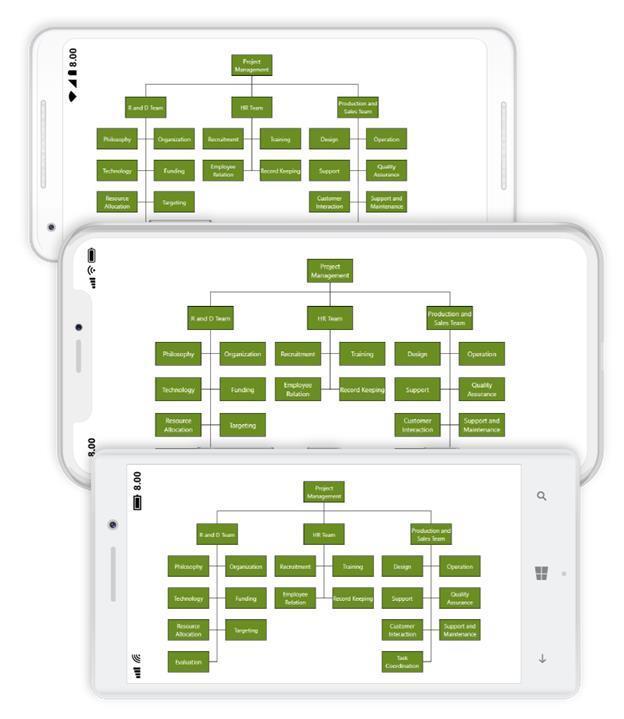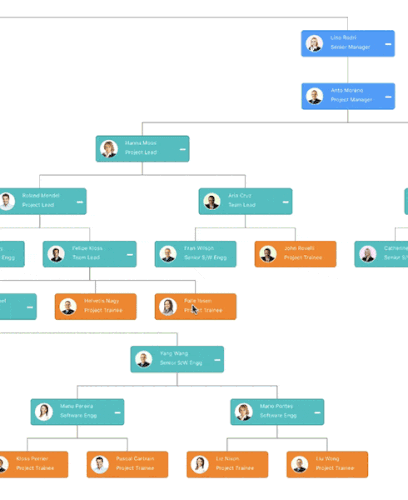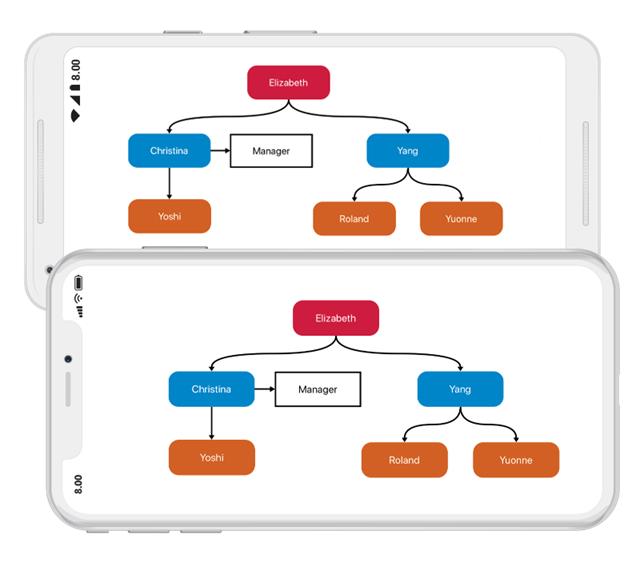Layout in Xamarin Diagram (SfDiagram)
20 Jan 202524 minutes to read
SfDiagram provides support to auto-arrange the nodes in the Diagram area that is referred as Layout.
We have explained the Automatic Layout with Employee class and DataSourceSettings.The followings are initial steps for all the Layout.
Create class for data
Now, you have to create a class, Employee with properties to store the employee’s information like Team, Role, ID, reporting person ID, etc. You also have to create a collection that stores a collection of the employees.
//Employee Business Object
public class Employee
{
public string Team { get; set; }
public string Role { get; set; }
public int EmployeeId { get; set; }
}
//Employee Collection
public class Employees : ObservableCollection<Employee>
{
}Initialize data source settings
<!--Initializes the DataSourceSettings -->
<control:SfDiagram.DataSourceSettings>
<control:DataSourceSettings x:Key="DataSourceSettings" ParentId="Team" Id="EmployeeId"
DataSource="{StaticResource Employees}" />
</control:SfDiagram.DataSourceSettings>// Initializes the DataSourceSettings
DataSourceSettings setting = new DataSourceSettings();
setting.DataSource = employee;
setting.Id = "ID";
setting.ParentId = "ReportingId";
diagram.DataSourceSettings = setting;Organization layout
An organizational chart is a Diagram that displays the structure of an organization and relationships. To create an organizational chart, Type should be set as LayoutType.Organization. The following code example illustrates how to create an organizational chart.
<ContentPage.Resources>
<ResourceDictionary>
<local:Employees x:Key="Employees">
<!--Employee Collection-->
<local:Employee EmployeeId="0" Role="Project Management" />
<local:Employee EmployeeId= "1" Role= "R and D Team" Team= "0"/>
<local:Employee EmployeeId= "3" Role= "Philosophy" Team= "1"/>
<local:Employee EmployeeId= "4" Role= "Organization" Team= "1"/>
<local:Employee EmployeeId= "5" Role= "Technology" Team= "1"/>
<local:Employee EmployeeId= "7" Role= "Funding" Team= "1"/>
<local:Employee EmployeeId= "8" Role= "Resource Allocation" Team= "1"/>
<local:Employee EmployeeId= "9" Role= "Targeting" Team= "1"/>
<local:Employee EmployeeId= "11" Role= "Evaluation" Team= "1"/>
<local:Employee EmployeeId= "156" Role= "HR Team" Team= "0"/>
<local:Employee EmployeeId= "13" Role= "Recruitment" Team= "156"/>
<local:Employee EmployeeId= "113" Role= "Training" Team= "156"/>
<local:Employee EmployeeId= "112" Role= "Employee Relation" Team= "156"/>
<local:Employee EmployeeId= "14" Role= "Record Keeping" Team= "156"/>
<local:Employee EmployeeId= "17" Role= "Production and Sales Team" Team= "0"/>
<local:Employee EmployeeId= "119" Role= "Design" Team= "17"/>
<local:Employee EmployeeId= "19" Role= "Operation" Team= "17"/>
<local:Employee EmployeeId= "20" Role= "Support" Team= "17"/>
<local:Employee EmployeeId= "21" Role= "Quality Assurance" Team= "17"/>
<local:Employee EmployeeId= "23" Role= "Customer Interaction" Team= "17"/>
<local:Employee EmployeeId= "24" Role= "Support and Maintenance" Team= "17"/>
<local:Employee EmployeeId= "25" Role= "Task Coordination" Team= "17"/>
</local:Employees>
<control:DirectedTreeLayout x:Key="TreeLayout" TreeOrientation="TopToBottom" Type="Organization"/>
</ResourceDictionary>
</ContentPage.Resources>
<ContentPage.Content>
<Grid x:Name="grid">
<control:SfDiagram x:Name="diagram" >
<!--Initializes the DataSourceSettings-->
<control:SfDiagram.DataSourceSettings>
<control:DataSourceSettings ParentId="Team" Id="EmployeeId"
DataSource="{StaticResource Employees}" />
</control:SfDiagram.DataSourceSettings>
<!--Initializes the Layout-->
<control:SfDiagram.LayoutManager>
<control:LayoutManager
Layout="{StaticResource TreeLayout}" />
</control:SfDiagram.LayoutManager> </control:SfDiagram>
</Grid>
</ContentPage.Content>//Employee Collection
ObservableCollection<Employee> employee = new ObservableCollection<Employee>();
employee.Add(new Employee { EmployeeId = 0, Role = "Project Management" });
employee.Add(new Employee { EmployeeId = 1, Role = "R and D Team" ,Team = "0" });
employee.Add(new Employee { EmployeeId = 3 , Role = "Philosophy", Team = "1" });
employee.Add(new Employee { EmployeeId =4 , Role = "Organization", Team = "1" });
employee.Add(new Employee { EmployeeId = 5 , Role = "Technology", Team = "1" });
employee.Add(new Employee { EmployeeId = 7, Role = "Funding" ,Team = "1" });
employee.Add(new Employee { EmployeeId = 8 , Role = "Resource Allocation" ,Team = "1" });
employee.Add(new Employee { EmployeeId = 9, Role = "Targeting" ,Team = "1" });
employee.Add(new Employee { EmployeeId = 11, Role = "Evaluation" ,Team = "1" });
employee.Add(new Employee { EmployeeId = 156 , Role = "HR Team", Team = "0" });
employee.Add(new Employee { EmployeeId = 13 , Role = "Recruitment", Team = "156" });
employee.Add(new Employee { EmployeeId = 113 , Role = "Training" ,Team = "156" });
employee.Add(new Employee { EmployeeId = 112 , Role = "Employee Relation" ,Team = "156" });
employee.Add(new Employee { EmployeeId = 14 , Role = "Record Keeping", Team = "156" });
employee.Add(new Employee { EmployeeId = 17 , Role = "Production and Sales Team" ,Team = "0" });
employee.Add(new Employee { EmployeeId = 119, Role = "Design", Team = "17" });
employee.Add(new Employee { EmployeeId = 19 , Role = "Operation", Team = "17" });
employee.Add(new Employee { EmployeeId = 20 , Role = "Support" ,Team = "17" });
employee.Add(new Employee { EmployeeId = 21 , Role = "Quality Assurance" ,Team = "17" });
employee.Add(new Employee { EmployeeId = 23 , Role = "Customer Interaction" ,Team = "17" });
employee.Add(new Employee { EmployeeId = 24 , Role = "Support and Maintenance" ,Team = "17" });
employee.Add(new Employee { EmployeeId = 25 , Role = "Task Coordination", Team = "17" });
//Set parentId and id for DataSourceSettings
DataSourceSettings setting = new DataSourceSettings();
setting.DataSource = employee;
setting.Id = "EmployeeId";
setting.ParentId = "Team";
diagram.DataSourceSettings = setting;
diagram.LayoutManager = new LayoutManager() { Layout = new DirectedTreeLayout() { TreeOrientation = TreeOrientation.TopToBottom, Type = LayoutType.Organization } };Organizational chart layout starts parsing from root and iterate through all its child elements. “BeginNodeLayout” event provides necessary information of a Node’s children and the way to arrange (Orientation, Type etc.) them.
BeginNodeLayout
User can change ChartType and Orientation by using BeginNodeLayout event of the SfDiagram. This event will fire for each Node added in Layout when the layout is getting updated. Default ChartType us Alternate and default orientation is Vertical. The following code example illustrates how to register an event and how to change ChartType and orientation.
// Registering an event
diagram.BeginNodeLayout += Diagram_BeginNodeLayout;
private void Diagram_BeginNodeLayout(object sender, BeginNodeLayoutEventArgs args)
{
if (!args.HasChildNodes)
{
args.Type = ChartType.Left;
args.Orientation = Orientation.Vertical;
}
}BeginNodeRender
User can change node content using BeginNodeRender event of the SfDiagram. This event will fire for each Node added in Layout when the layout is getting updated.
// Registering an event
diagram.BeginNodeRender += Diagram_BeginNodeRender;
private void Diagram_BeginNodeRender(object sender, BeginNodeRenderEventArgs args)
{
Node node = args.Item as Node;
node.Width = 150;
node.Height = 60;
node.ShapeType = ShapeType.Rectangle;
Syncfusion.SfDiagram.XForms.Style style = new Syncfusion.SfDiagram.XForms.Style(){Brush = new SolidBrush(Color.OliveDrab) };
node.Style = style;
AnnotationCollection annotations = new AnnotationCollection();
Annotation annotation = new Annotation()
{
Content = (node.Content as Employee).Role,
HorizontalAlignment = HorizontalAlignment.Center,
VerticalAlignment = VerticalAlignment.Center,
TextBrush = new SolidBrush(Color.White)
};
annotations.Add(annotation);
node.Annotations = annotations;
}Expand and collapse node
User can able to expand and collapse the parent node using NodeClicked event of the SfDiagram. This event will fire when click node in Layout.
// Registering an event
diagram.NodeClicked += Diagram_NodeClicked;
void Diagram_NodeClicked(object sender, NodeClickedEventArgs args)
{
if ((args.Item.Content as Employee).HasChild && args.Item.IsExpanded)
{
args.Item.IsExpanded = false;
}
else if ((args.Item.Content as Employee).HasChild && !args.Item.IsExpanded)
{
args.Item.IsExpanded = true;
}
}
NOTE
Diagram supports expand and collapse in Xamarin.Forms.Android and Xamarin.Forms.iOS alone.
Drag-and-drop support for directed tree layout
It is easier to drag a child or parent node to some other node in the directed tree layout. The following code shows how to enable draggable option in layout.
(diagram.LayoutManager.Layout as DirectedTreeLayout).IsDraggable = true;The following code shows how to add the child of dropped node while dragging the node using the LayoutNodeDropped event.
// Registering an event
diagram.LayoutNodeDropped += Diagram_OnLayoutNodeDropped;
//Define the LayoutNodeDropped event
private void Diagram_OnLayoutNodeDropped(object sender, LayoutNodeDroppedEventArgs args)
{
Node draggedNode = args.DraggedItem as Node;
Node droppedNode = args.DroppedItem as Node;
bool contain = true;
if (draggedNode != RootNode && draggedNode != droppedNode)
{
Node ParentNode = GetParent((droppedNode.Content as DiagramEmployee).ReportingPerson);
do
{
if (ParentNode != draggedNode)
{
contain = false;
}
else
{
contain = true;
break;
}
ParentNode = GetParent((ParentNode.Content as DiagramEmployee).ReportingPerson);
} while (ParentNode != RootNode);
if (!contain)
{
List<Connector> connectors = draggedNode.InConnectors as List<Connector>;
Connector con; bool hasChild = false;
for (int i = 0; i < connectors.Count; i++)
{
con = connectors[i];
con.SourceNode = droppedNode;
hasChild = true;
}
if (hasChild)
{
Node PrevParentNode = GetParent((draggedNode.Content as DiagramEmployee).ReportingPerson);
if (PrevParentNode != null && PrevParentNode.OutConnectors.Count == 0)
{
(PrevParentNode.Content as DiagramEmployee).HasChild = false;
UpdateTemplate(PrevParentNode, "-");
}
DiagramEmployee ParentEmployee = (droppedNode.Content as DiagramEmployee);
(draggedNode.Content as DiagramEmployee).ReportingPerson = ParentEmployee.Name;
ParentEmployee.HasChild = true;
UpdateTemplate(droppedNode, "-");
}
droppedNode.IsExpanded = true;
diagram.LayoutManager.Layout.UpdateLayout();
}
}
}
private Node GetParent(string parentId)
{
foreach (Node node in diagram.Nodes)
{
if ((node.Content as DiagramEmployee).Name == parentId)
{
return node;
}
}
return RootNode;
}
NOTE
Diagram supports drag and drop in Xamarin.Forms.Android and Xamarin.Forms.iOS alone.
Layout sibling spacing
It is easier to provide spacing between sibling nodes of any branch on the directed tree layout. Nodes can also be excluded from the layout. You can provide space for each node by customizing the “SiblingSpace” property of the node. The following code illustrates how to add space to nodes using sibling spacing class instance.
//Define the sibling spacing for node
private void Diagram_BeginNodeRender(object sender, BeginNodeRenderEventArgs args)
{
Node node = (args.Item as Node);
node.ShapeType = ShapeType.RoundedRectangle;
node.Width = 90;
node.Height = 50;
SiblingSpace siblingSpacing = new SiblingSpace(100,100);
node.SiblingSpace = siblingSpacing;
node.Annotations.Add(new Annotation() { Content = ((args.Item as Node).Content as Employee).Name });
}
EndNodeLayout
The EndNodeLayout event will be triggered when a node ends to layout. The following code example explains how to create a EndNodeLayout event.
<sfDiagram:SfDiagram VerticalOptions="FillAndExpand" x:Name="diagram" EndNodeLayout="diagram_EndNodeLayout" />SfDiagram diagram = new SfDiagram();
diagram.EndNodeLayout += Diagram_EndNodeLayout;
this.Content = diagram;
private void Diagram_EndNodeLayout(object sender, EventArgs e)
{
Node node = new Node { Width = 200, Height = 200, OffsetX = 100, OffsetY = 100 };
diagram.AddNode(node);
}NOTE
Diagram supports layout sibling with spacing in Xamarin.Forms.Android and Xamarin.Forms.iOS alone. You can refer to our Xamarin Diagram feature tour page for its groundbreaking feature representations.You can also explore our Xamarin Diagram example to understand how to present and manipulate data.